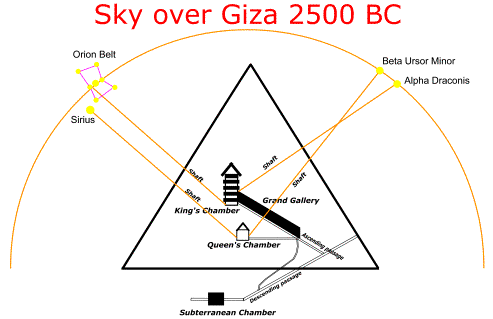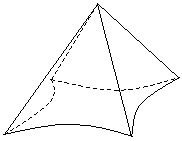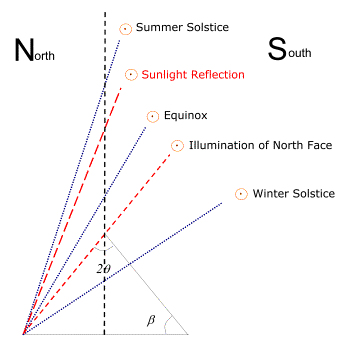|
Graham Hancock and Robert Bauval joined their forces and wrote the ‘The message of the Sphinx, A Quest for the Hidden Legacy of Mankind’. As the title suggests they claim to have decoded the secret messages of the monuments on the Giza plateau. According to Hancock and Bauval the Great Pyramid and the Sphinx at the Giza plateau must be dated back to at least 10.500 BC. Professor of geology Robert M. Schoch who examined this claim made by Hancock and Bauval found geological evidence to suggest that the deep erosion patterns at the base of the Sphinx were caused by water and not by wind and sand erosion as was commonly believed. Robert M. Schoch’s conclusions indeed suggest that the Sphinx should be dated back to at least 9000 B.C - 10.000 BC at the time that Egypt had long rainy periods after the end of the last Ice Age.
Hancock and Bauval in their book explain that the ‘air’ shafts inside the Great Pyramid aligned to the stars in the Belt of Orion and the pole star around 2500 BC. The southern shaft from the Queens Chamber aligned with the star Sirius at its culmination point on the meridian. This star was very important to the Egyptians and was associated with the mother Goddess Isis. The southern shaft emanating from the Kings Chamber aligned with the brightest star of the Orion Belt Zeta Orionis. This star was associated with the Egyptian God of resurrection and rebirth Osiris! The northern shafts aligned to the ancient pole star Alpha Draconis (Kings Chamber) and to Beta Ursa Minor (Queens Chamber).

The geometrical similarity between the three mains stars of the Belt of Orion and the pyramids Kufhu, Kafhre and Menkaure were apparent and also the Milky Way seemed to be mirrored by the river Nile on the plateau of Giza. However around 2500 BC the match was not perfect and only by winding back the precessional clock to the year 10.500 BC was the Hermetic principle ‘as above so below’ discovered. The celestial skies as they occurred over Giza around 10.500 BC were perfectly reflected in the layout of the pyramids and the river Nile on the plateau.
Around 10.500 BC Orion appeared perfectly over the meridian and reached its lowest elevation of 9° 20’ in the 26.000 year precession cycle. After reaching its lowest point the Belt of Orion started to climb back into the skies to reach an elevation of 45 degrees by 2500 BC, the time of the alignment of the southern air shaft with the brightest star of the Orion’s Belt. In our current era around 2000 AD Orion has reached its highest elevation of 59 degrees and for the next half a precession cycle Orion will be descending again.
Also the Sphinx on the Giza plateau fits into the grander picture of Hancock and Bauval’s theory. The Sphinx faces East at the exact location where the Sun rises on the day of the vernal equinox (21 March). At sunrise on the vernal equinox around 10.500 B.C. the Sun aligned itself with the constellation Leo, its own celestial counterpart image in the sky! Analysis of the Sphinx tells us that it symbolizes all of the four cardinal signs on the Zodiacal wheel, Leo, Taurus, Aquarius and Scorpio (the latter sign is often depicted as an eagle). The Sphinx has the body of a bull (Taurus), the wings of an eagle (Scorpio) the face of a man (Aquarius, water bearer) and an overall appearance of a lion (Leo).
These four cardial signs of the Zodiac are a recurring theme in ancient mythology and the Bible:
Eziekiel 1:10: As for the likeness of their faces, they four had the face of a man, and the face of a lion, on the right side: and they four had the face of an ox on the left side; they four also had the face of an eagle. (King James Version)
Revelations 4:6-7: And before the throne was a sea of glass like unto crystal in the midst of the throne and round about the throne were four beasts full of eyes before and behind. And the first beast was like a lion, and the second beast like a calf and the third beast had a face as a man, and the fourth beast was like a flying eagle. (King James Version)
At 2500 BC the vernal equinox was in the constellation Taurus which makes both Leo and Taurus the zodiac signs that have been engrained into the Giza plateau layout by design. We will discover another way these signs were put into the design later.
The date given for the construction of the Great Pyramid by the late psychic Edgar Cayce corresponds perfectly with the claims made by Hancock and Bauval. According to Cayce the Great Pyramid was built by refugees of the legendary Atlantis that was destructed after a great cataclysm that happened around 10.500 B.C. This date corresponds with the end of the last Ice Age. Around the world there are about three hundred known legends that speak of a great flood that once swept the Earth, the biblical Deluge that happened around 10.500 BC. The Egyptians called the time after the Deluge the Zep Tepi, the ‘First Time’ and it was symbolised by the symbol of the deity Aker, two lions sitting back to back one of them facing East and the other facing West with the Sun resting in their middle. Zep Tepi suggests some sort of a reset of the precessional clock, a zero point and the start of the early Egyptian era and the time that the Egyptian Gods such as Toth Osiris and Isis ruled the world.
Surprisingly new evidence has just come up that not only supports the Great Pyramid-Sphinx-Leo connection as proposed by Hancock and Bauval but at the same time ingeniously also links the Great Pyramid to Taurus. This new discovery made by Dr. Smelyakov will be ‘illuminated’ next.
In ancient times the Great Pyramid was covered by highly polished limestone casing stones that gave the pyramid a shining appearance like a big glittering diamond in the dessert. The ancients referred to it as ‘Ikhet, meaning the ‘Glorious Light’. In summertime the reflections of the pyramid could be seen from miles away. Its mirroring properties were enhanced by its concave structure of the faces. Each of the four faces of the pyramid are not perfectly flat but are slightly indented and curved to form a huge parabolic mirror reflecting the Sun’s rays.

Concave faces of the Great Pyramid
The significance of concavity of the faces in the construction of the pyramid can only be understood when we come to understand that the North face of the pyramid reflects the sunlight in between two critical positions during the tropical year when the Sun culminates over the Great Pyramid at noon. These critical positions that determine the start and end of the sunlight reflection correspond with the position of the Sun in the signs Leo and Taurus in the tropical Zodiac!
As the Sun starts to rise from its lowest position in the sky on the winter solstice point it reaches a critical height in the skies where the sunrays illuminating the South face of the pyramid will be reflected horizontally such that they can be observed by a spectator on the South side of the pyramid. This is the moment that the Great Pyramid starts to reflect the sunrays by its concave face. When the ascent of the Sun progresses the Sun finally reaches a point in the sky where it will shine over the top of the pyramid and starts to illuminate the North face of the pyramid as well. This happens shortly before spring (vernal equinox). When the ascend of the Sun progresses it reaches a point where the sunrays will be reflected off horizontally from the North face of the pyramid. This is when the reflected sunlight can be observed North of the pyramid.
The Sun finally comes to a standstill at the summer solstice after which it starts to descend again. The process of illumination of the pyramid now reverses. First the horizontal reflection of the sunrays on the North face seizes and next just before autumn (autumn equinox) the complete illumination of the north face seizes. In the picture below the height of the Sun that causes for a horizontal reflection of the sunlight on the North face is indicated in red. When the Sun reaches this position, spectators North of the pyramid will see the pyramid starting to shine like a crystal.

Positions of the Sun and the reflections of the sunlight
|
Event
|
Angle
|
|
Summer Solstice
|
90 - φ GP + ε = 83.4542°
|
|
Sun starts (stops) reflecting the sunlight on the Northern face
|
β = 51° 50’ 34” = 51.842773°
|
|
Equinoxes
|
90 - φ GP = 60.019167°
|
|
Winter Solstice
|
90 - φ GP - ε = 36.585833°
|
|
Latitude of the Great Pyramid
|
φ GP = 29° 58’ 51”
|
|
Obliquity of the Earth axis
|
ε = 23° 26’
|
|
Slope angle of the face of the pyramid
|
β = 51° 50’ 34”
|
The reflection of the sunlight by the Great Pyramid could have been observed even today if the casing stones were still in place. This reflection is no coincidence and exists due to the unique relations between:
- The latitude of the Great Pyramid (29° 58’ 51”).
- The alignment to the four cardinal points (North, South, East West)
- The slope angle of the faces of the Great Pyramid (51° 50’ 34”)
- The obliquity of the Earth axis (23° 26’)
To get an idea of the precision that went into the construction of the Great Pyramid and the delicacy of the parameters mentioned above, consider its alignment to the 4 cardinal points. The meridian running through the Great Pyramid deviates from the perfect North-South meridian by 3 arc minutes (3/60 part of a degree). With all our modern technology this precision couldn’t even be achieved in the construction of the Greenwich Observatory in London that marks the Prime Meridian of the world with an inaccuracy of 9 arc minutes and is therefore three times less accurate than the Great Pyramid!
With this stunning accuracy in the back of our minds we can start to appreciate the accuracy that went into the design of this sunlight reflection phenomena of the Great Pyramid.
The Sun's positions in the tropical Zodiac which correspond to the Sun’s daily culminations (at noon) over the Great Pyramid during a tropical year can be charted as follows:

Ecliptic positions of the Sun at its critical
culminations over the Great Pyramid
Not only does this chart represent the esoteric Star of David, also the correlation between the Great Pyramid and the constellations Leo and Taurus are immediately revealed! The critical points of the sunlight reflection on the Zodiac correspond with the tropical Zodiacal coordinates 15 degrees Taurus (reflection start) and 15 degree Leo (reflection end)!
One could argue that this phenomenon of the sunlight reflection by the Great Pyramid and its relation to the 15 degrees Taurus and Leo positions is pure happenstance, but it becomes hardly unlikely when we take into account that this coincidence happens to depend on the perfect combination of the pyramid’s latitude, slope angle, obliquity of the Earth axis and the pyramid’s alignment to the cardinal points! So it seems that the Great Pyramid has been intentionally linked to the astrological signs of both Leo and Taurus!
The discovered connections of the Great Pyramid to the constellation of Leo and Taurus as discussed in this article are not coincidental but were carefully designed into the overall design of the Giza plateau. The Giza Pyramid’s-Leo-Taurus connection can now be summarized as follows:
- The Giza plateau represents the Belt of Orion on the ground according to the Hermetic principle ‘as above so below’ at the Age of Leo as discovered by Hancock and Bauval and recently confirmed by Wayne Hershel.
- The Sphinx symbolizes the 4 cardinal point of the Zodiac Leo, Taurus, Aquarius and Scorpio but its main appearance is that of a lion (Leo).
- The Sphinx aligned with the constellation Leo at 10.500 BC on the vernal equinox
- The Great Pyramid aligned with Sirius, Orion, Beta Ursor Minor and Alpha Draconis when the vernal equinox was in the constellation Taurus.
- The geometry (angles) of the Sphinx and the pyramids corresponds with the geometry of Leo and the Orion belt respectively.
- The Great Pyramid is connected to the signs of Leo and Taurus by means of the reflection of the sunlight. The reflection is triggered when the Sun reaches the midpoint of the signs Taurus and Leo on the tropical Zodiac.
So why are Leo and Taurus so important? What do they represent?
The sign of Leo may has been incorporated into the overall design of the Giza plateau as a reference to the date 10.500 BC for the construction of the Great Pyramid as shown by the research of Hancock, Bauval and Schoch and independently corroborated by the great psychic Edgar Cayce who mentioned this date as the construction date of the Great Pyramid.
And if we now turn the hour hand on the precession clock half an hour forwards from the Age of Leo we end up in our current era. The ingenious ancient architects of the Giza plateau may have left us also a monument of time, a precession clock and marker to our own New Age where we have finally reached the scholarly maturity to decode their mysteries and awaken to a new reality, the fact that just maybe the Gods of the Heavens in the ancient mythologies were not Gods at all, but were beings of flesh and blood who came from the Heavens and walked among men to create these magnificent and mind boggling monuments.
References:
Dr. Smelyakov is a professor in mathematics at two universities in Kharkov, Ukraine and a member of several academic councils. He’s also ISAR Vice-President for Ukraine (The International Society for Astrological Research) and a member of the “Golden Fund” of Cyclic Science of Russia and president of the Kharkov Regional Astrological Center (www.astrotheos.com). Dr. Smelyakov discovered this sunlight reflection phenomenon of the Great Pyramid.
http://www.astrotheos.com/Page7.htm
http://en.wikipedia.org/wiki/Great_Pyramid_of_Giza
http://www.crystalinks.com/zeptepi.html
http://www.sacred-texts.com/
“The message of the Sphinx, A Quest for the Hidden Legacy of Mankind”, Graham Hancock and Robert Bauval, Three Rivers Press, 1997.
|

